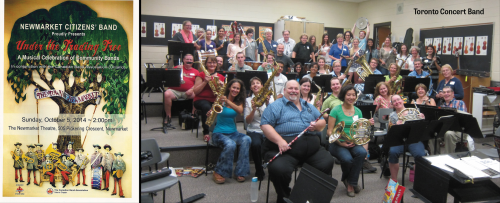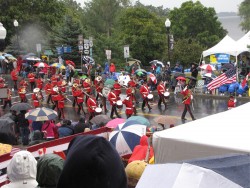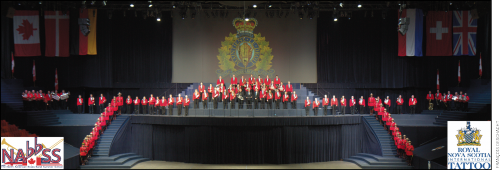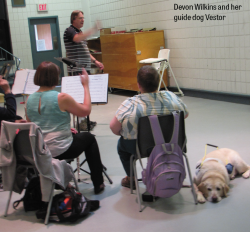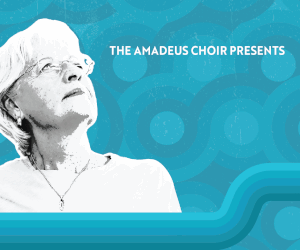A Night to Remember
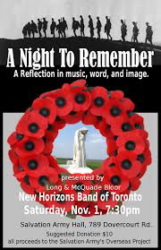 Ever since their inaugural days in Toronto, I have been a keen advocate of the New Horizons Bands in this part of the country. When I was invited to join the senior Toronto New Horizons band and sit in for one of their performances in early November, I was pleased and accepted. I thought that this was to be a typical fall band concert. I couldn’t have been more mistaken.
Ever since their inaugural days in Toronto, I have been a keen advocate of the New Horizons Bands in this part of the country. When I was invited to join the senior Toronto New Horizons band and sit in for one of their performances in early November, I was pleased and accepted. I thought that this was to be a typical fall band concert. I couldn’t have been more mistaken.
I had been told that the concert was to be at the nearby Salvation Army Dovercourt location as a thank-you for the many times that the band had been able to rehearse there when their regular rehearsal space was unavailable. Since the title of the event was “A Night to Remember,” and since it was just a few days before November 11, I assumed that it would be a remembrance concert. However, in his planning, director Dan Kapp wanted something more respectful of the pain and suffering at home and with members of the forces during their times of separation.
Kapp’s research on the internet led him to a book titled One Family’s War: The Wartime Letters of Clarence Bourassa, 1940-1944.This is primarily a collection of letters written by Private Clarence O. Bourassa, of the South Saskatchewan Regiment, to his wife Hazel from March 1940 to July 1944, when he was killed, aged 30, in the Battle of Normandy. It was edited by Clarence’s son Rollie. While on leave in England, Clarence had established a friendship with one family, and letters from Dorothy Starbuck to Hazel have been included in this collection.Clarence’s letters reveal the complexity of the emotional life of the Canadian soldier far from his beloved wife and two children. Obviously, it would not have been possible to obtain any of Hazel’s letters to Clarence, but Dorothy’s letters provide much insight.
Once he had read the book, Kapp knew that he had the basis of what he wanted. In his words: “It was clear that this was all I really needed to tie the show together.” It would chronicle, with musical interludes, the many torments of the war for a young soldier and his family. (One extra tie-in was that, while in England, whenever he had the opportunity, Clarence played euphonium in a Salvation Army band.)
After discussion with Salvation Army Major Doug Hammond, the format for the event was agreed upon. Advertised as “A Night to Remember,” there would be no admission charged. Instead, audience members wwould be invited to donate to a charitable program in Zimbabwe sponsored by this Bloor Central Corps.
During World War I conductor Eugene Goossens put out a call for a fanfare to be played at the beginning of every concert in Britain during the war. It had been very successful. So, shortly after the United States entered World War II, Goossens, now in the U.S., put out a similar call. Of all of the submissions, Aaron Copland’s Fanfare for the Common Man is the only one to have survived. It couldn’t be a more appropriate selection to open this remembrance program. In any war it is the “common man,” not the leader, who must carry on the fight.
The event that followed the fanfare was a multimedia look at the struggles of one such common man from small-town Saskatchewan. Private Clarence O. Bourassa was that common man. As the program progressed, between musical interludes, Ken Hodge, a member of the band, read letters from Clarence to his wife as a wide variety of war scenes and other images were projected on the screen behind. At other times Lisa Kapp, also from the band, read letters from Dorothy to Hazel.
Throughout the program no fewer than 120 photos or posters were projected on the screen. From a band member’s vantage point, even with no opportunity to see the images on the screen, it was a very moving evening. On speaking to some audience members who had the benefit of the combination of music, dialogue and images, they indicated that the impact was considerable. This format is one which could well be employed by school teachers when planning remembrance services in future years. Once again Dan Kapp deserves congratulations for making remembrance ceremonies more meaningful.
Wychwood Clarinet Choir: Another recent musical event deserving mention was the “Wind Song” concert offered by the Wychwood Clarinet Choir this past month. Having awarded Howard Cable with the title of conductor-in-residence, or something similar, it was only natural that he would play a significant role in the choir’s recent concert. The name of the concert came from the name of one of Cable’s first compositions for clarinet choir when he was the civilian associate conductor and arranger with the NORAD Command Band in Colorado Springs in 1964. Wind Song was the opener for the second half of the program which featured Cable as composer, arranger and conductor. The program closed with his Wychwood Suite which was written to showcase the solo artistry of the choir’s conductor Michele Jacot.
A new group: While it isn’t a band, Strings Attached is a new community ensemble. As the name might suggest, the group is a Toronto-based, member-run string orchestra made up of adult, amateur string musicians. The orchestra was formed in the summer of 2014, when three violinists and a cellist got together with a plan to form a group that would suit their needs. Specifically, they wished to play a diverse repertoire of music arranged or written for strings, with a group of like-minded, dedicated amateur musicians. While, like other amateur groups, a primary objective is the personal enjoyment of making music, their goal is also to serve the community at large with performances at nursing homes, hospitals and similar venues. Interest in the project grew quickly and Strings Attached now has over 25 members and is growing.
Conductor Ric Giorgi is a Toronto jazz bassist, pianist and singer, with a broad history of composing music for film and television, as well as having conducted various local orchestras and ensembles including the Scarborough and Toronto District School Board Music Camps. Under his baton, Strings Attached meets every Monday from September to June in the Bathurst and Sheppard area.
It is unusual to hear a new group state that some sections are full, but that is the case here. They say that their cello section is full and the viola and bass sections are close to capacity. However, they are currently looking for more violins. Anyone with a background in playing a string instrument, and an interest in playing with a friendly, encouraging group, is welcome to visit their website or pay a visit to a rehearsal.
Concerts coming: Last month I mentioned that the new Toronto Concert Band had begun rehearsals in west end Toronto in September. Now, only two months after their first rehearsal, they have just confirmed the venue for their inaugural public performance. Rather than perform in a local location, they wanted to reinforce their mandate of serving the entire City of Toronto, and have selected the CBC Glenn Gould Studio for their first appearance on the local music scene. Under the direction of conductors Les Dobbin and Ken Hazlett they will kick off their season on Saturday, January 31, at 8pm.
See the listings section for concerts by The Encore Symphonic Concert Band (Dec 4, Jan 8, Feb 5), The Festival Wind Orchestra (Dec 14), The Pickering Community Concert Band (Dec 14) and the Flute Street Flute Choir (Jan 31).
Concert missed: By the time this issue is off the press, the annual “Seasonal Celebration” of the Markham Concert Band on Sunday November 30 will be history. Unfortunately the information on that concert wasn’t received in time. One work scheduled for that program was a composition by Louie Madrid Calleja, who came to Canada from the Philippines and holds a master’s degree from York University. The information received does not mention the title of the work. Perhaps it was his Soliloquy for Band Op. 40a which was well received at the CBA Community Band Weekend in October. Keep your ears open. We should be hearing more from this young composer in the future.
Definition Department: This month’s lesser known musical term is maestro: A person who, standing in front of the orchestra and/or chorus, is able to follow them precisely.
We invite submissions from readers. Let’s hear your daffynitions.
Jack MacQuarrie plays several brass instruments and has performed in many community ensembles. He can be contacted at bandstand@thewholenote.com.


